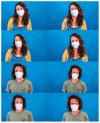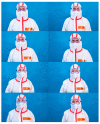How Are You Feeling? Interpretation of Emotions through Facial Expressions of People Wearing Different Personal Protective Equipment: An Observational Study
- PMID: 36278768
- PMCID: PMC9590080
- DOI: 10.3390/nursrep12040075
How Are You Feeling? Interpretation of Emotions through Facial Expressions of People Wearing Different Personal Protective Equipment: An Observational Study
Abstract
(1) Background: The perception of others' emotions based on non-verbal cues, such as facial expressions, is fundamental for interpersonal communication and mutual support. Using personal protection equipment (PPE) in a work environment during the SAR-CoV-2 pandemic challenged health professionals' ability to recognise emotions and expressions while wearing PPE. The working hypothesis of this study was that the increased limitation of facial visibility, due to the use of a personal protective device, would interfere with the perception of basic emotions in the participants. (2) Methods: Through a cross-sectional descriptive study, the present research aimed to analyse the identification of four basic emotions (happiness; sadness; fear/surprise; and disgust/anger) through three types of PPE (FFP2 respirator, protective overall and powered air-purifying respirator (PAPR)), by using 32 photographs. The study was conducted using volunteer participants who met the inclusion criteria (individuals older than 13 without cognitive limitations). Participants had to recognise the emotions of actors in photographs that were randomly displayed in an online form. (3) Results: In general, the 690 participants better recognised happiness and fear, independently of the PPE utilised. Women could better identify different emotions, along with university graduates and young and middle-aged adults. Emotional identification was at its worst when the participants wore protective overalls (5.42 ± 1.22), followed by the PAPR (5.83 ± 1.38); the best scores were obtained using the FFP2 masks (6.57 ± 1.20). Sadness was the least recognised emotion, regardless of age. (4) Conclusions: The personal protective devices interfere in the recognition of emotions, with the protective overalls having the greatest impact, and the FFP2 mask the least. The emotions that were best recognised were happiness and fear/surprise, while the least recognised emotion was sadness. Women were better at identifying emotions, as well as participants with higher education, and young and middle-aged adults.
Keywords: coronavirus infections; expressed emotion; health personnel; professional burnout; protective devices.
Conflict of interest statement
The authors declare no conflict of interest. The funders had no role in the design of the study; in the collection, analyses, or interpretation of data; in the writing of the manuscript; or in the decision to publish the results.
Figures




Similar articles
-
Exploring Emotion Recognition Patterns Among Iranian People Using CANTAB as an Approved Neuro-Psychological Assessment.Basic Clin Neurosci. 2023 Mar-Apr;14(2):289-295. doi: 10.32598/bcn.2022.3607.1. Epub 2023 Mar 1. Basic Clin Neurosci. 2023. PMID: 38107531 Free PMC article.
-
Face masks have emotion-dependent dissociable effects on accuracy and confidence in identifying facial expressions of emotion.Cogn Res Princ Implic. 2022 Feb 14;7(1):15. doi: 10.1186/s41235-022-00366-w. Cogn Res Princ Implic. 2022. PMID: 35157157 Free PMC article.
-
Mapping the perception-space of facial expressions in the era of face masks.Front Psychol. 2022 Sep 13;13:956832. doi: 10.3389/fpsyg.2022.956832. eCollection 2022. Front Psychol. 2022. PMID: 36176786 Free PMC article.
-
Task characteristics influence facial emotion recognition age-effects: A meta-analytic review.Psychol Aging. 2020 Mar;35(2):295-315. doi: 10.1037/pag0000441. Epub 2020 Jan 30. Psychol Aging. 2020. PMID: 31999152 Review.
-
Partly dissociable neural substrates for recognizing basic emotions: a critical review.Prog Brain Res. 2006;156:443-56. doi: 10.1016/S0079-6123(06)56024-8. Prog Brain Res. 2006. PMID: 17015095 Review.
References
-
- World Health Organization Rational Use of Personal Protective Equipment (PPE) for Coronavirus Disease (COVID-19), Interim Guidance. Mar 19, 2020. [(accessed on 14 July 2021)]. Available online: https://covid19-evidence.paho.org/handle/20.500.12663/840.
Grants and funding
LinkOut - more resources
Full Text Sources
Miscellaneous

